History of Turkmenistan
Topic: Turkmen History

When writing the Turkmen history, it will be appropriate to speak first of the history of Turkmenistan where the Turkmens currently live. Archeological excavations show that people lived in today's Turkmenistan 3000.000 years ago. Scientists think that the Caspian Sea, which was much lager than it is now, began to dry up and recede and this process resulted in the birth of the Kara-Kum desert. In those ages particularly in the neolithic age, agriculture was prevalent in the Southern Turkmenistan while cattle-breeding and fishing were developed in the North. From relics found in the Togalak-Depe, Chopan-Depe and Geok-Depe areas, it appears that the first human settlement in Turkmenistan occurred between 7000 and 5000B.C. Turkmen people created various wonderful world of art, in which its history, mode of life, religious beliefs and thoughts were incarnated.
Sculpture is one of the ancient kind of the fine arts. Having apppeared in the neolithic period it underwent difficult and multi-stage way of development. Nature worship, magic rites-these were conditions under which the ancient neolithic art of ancestors of Turkmen was formed.
In the 6th century B.C. the territory of the modern Turkmenistan was conquered by the Pesian Dynasty of Akhemenids, in the 4th century B.C. the southern part of the modern Turkmenistam was conquered by the troops of Alexander the Great. In the middle of the 3d century B.C., Macedonian rule was over and was replaced in 247 B.C. by the state of Parthia. The Royal Residence of the Parthian State was located in the Old Nisa. Taking good advantages of Turkmenistan's position on the Great Silk Route, the Parthians had an active economic and commercial life and established cities. During the regime of the King Mitridat I, the first Parthian coin (called "Drahma") was minted in silver. Horn-shaped ivory rhytons (vessels), marble statues and silver figurines of the ancient Greek Gods were found during the excavations at the Old Nisa. The Parthian culture by itself was a composition of the Greek and Oriental cultures. In the context of agriculture which was considerably developed in the Parthian period wheat, barley, corn (maize), rice, cotton and various fruits were grown. One of the most important features of the Parthian age was the use of the Aramaic script. The Parthian State which lasted for 470 years, collapsed in 224 A..D..
Another culture that flourished in Turkmenistan was in the Khorezm area. Khorezm corresponds more or less to the same period as the Parthian State.
As the Parthian state ended in the southern Turkmenistan in the 3d century A.D., a short period of the Sassanids began in the area. In the second half of the 5th sentury A.D. Turkmenistan came under the domination of another group, the Ephtalities.
This represents the beginning of Turkic domination in Turkmenistan. As a matter of fact, the 6th century in Turkmenistan is known as the century of the Turkic Khagans.
The Arabs came to Turkmenistan in the middle of the 7th century.The Arabs conquered western Turkmenistan and the Khorezm area after several battles and subjugated the whole Turkmenistan. In the 9th century, the Arab rule in Turkmenistan disintegrated and was replaced by the Takhirids and Samanids. The Gaznavians who emerged in the 10th century put the end to the Samanids rule and started their own era. Oguz-Turkmen movement of the 11-12 centuries led to formation of the large empire, which stretched from the Middle Asia to Syria and Palestine and was ruled by the Seldzuks dynasty.
Seldzuk sultans gave much attention to science and art as well as construction. Economic potentialities of the powerful military and political state stimulated the thriving of many trades including art construction. The most wonderful and significant construction of the Seldzuk1 s period is, undoubtedly, mausoleum of sultan Sanjar in MERV, created by architect of genuis Mukhammed ibn-Atsyz from Serakhs. Thus as a result of synthesis of ancient architectural-planning traditions with rich ornamentations of oguz tribes in the Seldzuk period there appeared magnificient works of architecture, many of which preserved to our time and which are priceless historical and cultural legacy of the Turkmen nation.
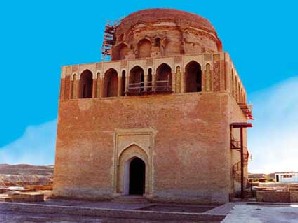
At the end of 11th century the Seljuk Empire was broken up into two parts: the Eastern and the western Seljuks. The latter reigned in Anatolia, Iraq and Syria, and the former in Iran, Khorosan, Turkmenistan, Transoxiana andAfganistan.
The Khwarizmshahs who had a long past in Turkmenistan began to rise in the tenth century. Their capital city was Gurganj (Old Urgan) near the city of Dashoguz in the North of today's Turkmenistan. The Khwarizshahs who enjoyed autonomy during the Seljuki period had already left their imprint on economic and social life and reached an advanced level of development. In the regime ofAnush Tegin, Kutbeddin Mohammed, Adsyz and his son llarslan, the Khwarizmshahs extended frontiers from the Oxus to Irag particularly between the tenth and twelfth centuries.
During the reign of Sultan Jalaleddin Khwarizmshah, the Khwarizmshahs captured Iran, Irag, the enrire Central Asia, Kazakhstan and northern India and became the greatest state in the East. They built a civilisation that was superior to their contemporaries in culture, arts and architecture. This civilisation, which brought glass skillfully, has a continuing impact on architecture with its thousands of works. The Mamnug Academy in Gurganj was one of the major centers of science of the time. Avecenna, who is said to have invented 700 drugs in the world pharmacologic history, the great mathematician AI-Beruni and other important scientists such as AI-Khwarizmi and As-Samani were all people who had been trained in these institutions off science.
Taking advantage of internal and external disturbances which emerged in the land of Khwarizm, the Mongols launched an attack with a strong army in late 1219. The Khwarizmian king Shah Mohammed 2 nd., convened the war assembly and discussed the situation. Rejecting the proposal that it would be more appropriate to confront the enemy on the banks of the Jaxartes from the viewpoint of protecting the people, the king decided that each city be protected against the Mongols separately. This decision was to prove more beneficial for the Mongols. As a matter of fact, the armies of Genghiz Khan repidly overran cities like Otrar, Bokhara and Samarkant. The Khwarizmian King who did not surrender to the Mongols fled to the Abeskun Island in the Caspian Sea and died there. Just before his death, he ordered that Jalaleddin should become king.
As the Mongol army continued to advance in the land of Khwarizm and began to capture cities of Northern Khwarizm one by one, Jatalleddin Khwarizmshah went into action to protect Gurganj. However, as Turken Khatoun in the capital city did not allow him any say in this work, he withdrew to the south and there defeated the advance units of the Mongol army who were entering into the area. In 1221, the Mongol armies commended by Genghis Khan's sons Chuchi, Chagatai and Ogdai attacked Gurganj from four sides and, after a six-month deference, captured the city. Certain sources state that the Mongols slaughtered nearly one milion people during this war.
The Mongol raids caused upheaval to economic and civil life in Turkmenistan and in the Khwarizmian state. Libraries, dams, mosques and institutions of science were destroyed and hundreds of thousands of people were ruthlessly slain.
Certain Turkmen clans who survived these horrors saved themselves from extinction by migrating to various places.
While some of the Turkmens fleeing the Mongol invasion went to Anatolia, some migrated to Afghanistan and Pakistan and some other stayed in Turkmenistan.
Immediately following the Mongol invasion, the lands of Turkmenistan were divided among the sons of Genghis Khan, with Chuchi taking the North, Hulagu the South and Chagatai the East.
After the Mongols disintegrated as a result of internal strife, Tamerlane brought the Turkish tribes together and formed a powerful state which restored stability in Turkestan. Having captured Khwarism and most of Turkmenistan in 1388, Tamerlane then destroyed the Golden Horde and extended his domination to the north. Historical sources state that Tamerlane levelled the city of Urganj to the ground and turned it into farming land, because its people had opposed him, and brought chaos on the social, commercial and cultural life of the region. Having recruited thousands of Turkmens as cavalrymen into his army after invading Turkmenistan, Tamerlane with his disciplined army made expeditions to Iran, India and the Caucasus and won most of his battles, establishing a large empire whose capital city was Samarkant. Reigning between 1370 and 1405, Tamerlane died in the days when he was planning a big expedition to China. Under Shahrukh and Ulug Beg, the two sons of Temerlane who succeeded him as rulers of his empire, an advanced level was reached in Turkestan in science, culture, arts, agriculture urbanism. Activities in the field of astronomy in particular were unequalled for many centuries to come. In the observatory built in this period, the length of a year was calculated with an error of only 4 minutes. However, as a result of failure in administration against the successes in science, coupled with a power struggle among the sons of Tamerlane, the state broke up and was replaced by the Uzbek Khanate.
During the Mongol period and the reign of Tamerlane, many Turkmen tribes like Teke, Salur, Yamut and Ersaru scattered widely from Turkmenistan into Iran, Irag, Syria, the Caucasus and Turkey. Of these tribes, the Turkmens Akkoyunlu (White Sheep) and Karakoyunlu (Black Sheep) who established states in western and northern Iran and in eastern Anatolia founded a great civilisation between the thirteenth and sixteenth centuries. According to historical sources, Bayram Khan who went to India and made a great reputation there had come from the Turkmens of Karakoyunlu.
When the Uzbek Khan Shaybani who had replaced the state of Tamerlane was defeated by Shah Ismael in Merv in 1510, Turkmenistan was invaded by the Saffawis, but the Turkmens who lived in Khwarizm united with the Uzbeks and did not allow the Safawis to settle permanently in the region.
Later on, the Uzbeks and the Turkmens founded a Khanate known as the Khwarizm or Khiva Khanate. Although this Khanate dominated the greater part of Turkmenistan, the Turkmens in Merv, Akhal and Etrek kept their independence and simply paid a tribute to the Khanate.
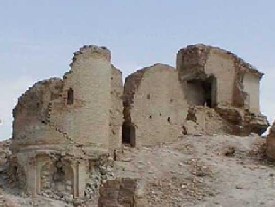
The history of Turkmenistan from the Sixteenth Century until the Mid-Nineteenth Century was determined by the relations among the state of Iran, Khiva and Bokhara. However, as the wars among these states in this period took place mostly in the lands of Turkmenistan, they damaged most the Turkmens. In this period, there were power struggles between the Uzbeks and the Turkmens. Abul Gazi Bahadur Khan who was in power between 1645 and 1663 caused various difficulties to the Turkmens, coupled with the impact of the drought that occured at about the same period, most of the Turkmens within the Khanate re - settled themselves around Akhal, Etrek, Murgap and Tedjen. In this period, many of the Turkmens living around the Lake Aral left their homelands because of pressures from both the Khanate of Khiva and the Kalmuks and migrated to around Astrakhan and Stavropol in northern Caucasus.
In spite of the distresses it went through in the Sixteenth to Eighteenth Centuries, the Turkmen people did not lose its productivity in cultural life. Popular legends like Koeroghlu (the Son of the Blind Man), Shahsanem Garib, Leila and Mejnun, and Taher and Zuhra, are products of this period with all its events that had a negative impact on social and cultural life. These legends covered such themes as love, partriotism, honesty, friendship and family values. The poets and thinkers of the time such as Devlet Mehmed Azadi and Makhtumkuli treated those themes and also guided the Turkmens towards the idea of a single state in unit and solidarity.
The Turkmens and the Russian who had commercial relations in previous centuries started to develop these relations in the nineteenth century, particularly between 1819 and 1836, the Russian made frequent visit to Turkmenistan to establish trade links, to find new markets and develop a military strategy. Having started to occupy the Khanates of Turkestan in the 1860's, the Russian built a castle in 1869 in Kyzilsu (Krasnovodsk) on the shore of the Caspian and deployed a large number of troops there.
In 1864-1865, the Russian occupied the Khanate of Hokand and took Tashkent and Samarkant. In 1868-1871, they conquered Khanate of Bokhara and established on the lands of these two Khanates the "General Govemorate of Turistan" to which they appointed General Kaufman. In 1874, they founded the "Transcaspian Military Unit" and General Lomakin was appointed as its head. Bringing Bokhara and Khiva under their control, the Russians advanced from the Caspian to the Akhal area and continued to occupy new territories. Thereupon, the Turkmen's led by Berdi Murad Khan, the son of Nurberdi Khan, fortified the Geok-Tepe Castle and dug deep pits around it. The Russians attacked Geok-Tepe in August 1879 and pounded the castle with artillery fire for many days, and hundreds of Turkmen's lost their lives. After the bombing ended, the Turkmens launched an attack on the Russians and drove them back to the shores of the Caspian. However, Berdi Murad Khan fell martyr in this battle.
In December 1880, the Russians came back to Geok-Tepe. The Russians dug underground tunnel into the castle and blew up its gate with 1160 kilogrammes of explosives.
After the battle at Geok-Tepe, the Russians entered into Ashkhabat in 18th of January 1881. The tsarist government established an administration under the name of the Eastern Caspian region and included in it the cities of Mangeshlak, Kyziisi, Ashkhabat, Tedjen and Merv.
Seventy years Turkmenistan was in the composition of the USSR. On the 27th of October, 1991, the 10th extraordinary session of the Supreme Council of the Turkmen Soviet Socialist Republic had adopted the constutional law "independence and foudation of the state system of Turkmenistan" This day was announced as Turkmenistan Independence Day.
Source: www.asia-travel.com

Posted by countryturkmenistan
at 11:47 AM
Updated: Monday, 30 May 2005 12:54 PM
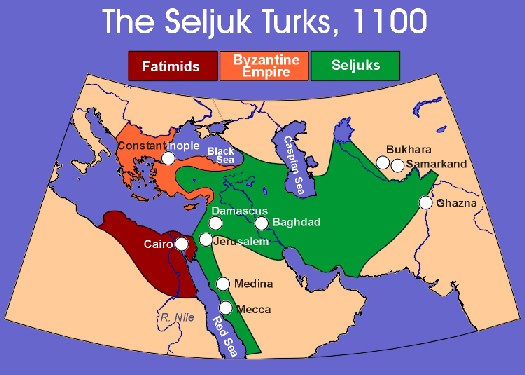

 The Turkmen made the transition to an agricultural lifestyle fairly recently and their cultural characteristics are unique in many ways.
The Turkmen made the transition to an agricultural lifestyle fairly recently and their cultural characteristics are unique in many ways.  In an unexpected benefit of the Cold War's end, Russian and American archaeologists say they have discovered an ancient civilization that thrived in Central Asia more than 4,000 years ago, before being lost in the sweep of history.
In an unexpected benefit of the Cold War's end, Russian and American archaeologists say they have discovered an ancient civilization that thrived in Central Asia more than 4,000 years ago, before being lost in the sweep of history. 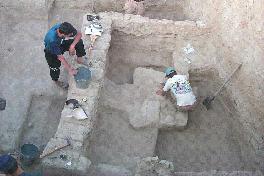 Mr. Mair said that discovery of ruins of an advanced culture in a region "where there was thought to be just space and emptiness fills an enormous gap" in terms of trade and cultural exchange across Asia in antiquity.
Mr. Mair said that discovery of ruins of an advanced culture in a region "where there was thought to be just space and emptiness fills an enormous gap" in terms of trade and cultural exchange across Asia in antiquity. 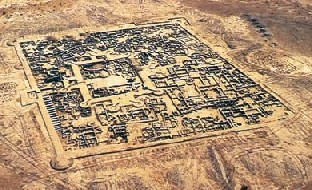 A new book by well-known Russian archaeologist Victor Sarianidi about excavations in the ancient country of Margush is published in Turkmenistan
A new book by well-known Russian archaeologist Victor Sarianidi about excavations in the ancient country of Margush is published in Turkmenistan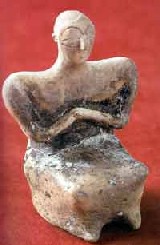 We were lucky to open the tsar’s funeral complex where you can find not only the defunct but also symbols of statehood as well: stone scepters that were used as an attribute of power in ancient times; pictures of eagles in the golden cover, golden and silver vessels, traces of rich sacrifices, mosaic on walls and hearses that still has no analogy in Central Asia. Moreover, several true masterpieces of the ancient jewellery art feature among the masses of findings. First of all, it is a small sculpture of djeiran made of gold and a sculpture of a lion cub turned in turquoise. Their size is less than a centimeter but you can see all the details of the amazing works of ancient masters of Turkmenistan through magnifying lens. The works merit being included into the Guinness Book of Records. I hope that these masterpieces will be soon displayed in the new Museum of Fine Arts in Ashgabat for they represent the earliest pieces of the art of ancestors of the Turkmen people.
We were lucky to open the tsar’s funeral complex where you can find not only the defunct but also symbols of statehood as well: stone scepters that were used as an attribute of power in ancient times; pictures of eagles in the golden cover, golden and silver vessels, traces of rich sacrifices, mosaic on walls and hearses that still has no analogy in Central Asia. Moreover, several true masterpieces of the ancient jewellery art feature among the masses of findings. First of all, it is a small sculpture of djeiran made of gold and a sculpture of a lion cub turned in turquoise. Their size is less than a centimeter but you can see all the details of the amazing works of ancient masters of Turkmenistan through magnifying lens. The works merit being included into the Guinness Book of Records. I hope that these masterpieces will be soon displayed in the new Museum of Fine Arts in Ashgabat for they represent the earliest pieces of the art of ancestors of the Turkmen people.
 The history of Turkmenistan from the Sixteenth Century until the Mid-Nineteenth Century was determined by the relations among the state of Iran, Khiva and Bokhara. However, as the wars among these states in this period took place mostly in the lands of Turkmenistan, they damaged most the Turkmens. In this period, there were power struggles between the Uzbeks and the Turkmens. Abul Gazi Bahadur Khan who was in power between 1645 and 1663 caused various difficulties to the Turkmens, coupled with the impact of the drought that occured at about the same period, most of the Turkmens within the Khanate re - settled themselves around Akhal, Etrek, Murgap and Tedjen. In this period, many of the Turkmens living around the Lake Aral left their homelands because of pressures from both the Khanate of Khiva and the Kalmuks and migrated to around Astrakhan and Stavropol in northern Caucasus.
The history of Turkmenistan from the Sixteenth Century until the Mid-Nineteenth Century was determined by the relations among the state of Iran, Khiva and Bokhara. However, as the wars among these states in this period took place mostly in the lands of Turkmenistan, they damaged most the Turkmens. In this period, there were power struggles between the Uzbeks and the Turkmens. Abul Gazi Bahadur Khan who was in power between 1645 and 1663 caused various difficulties to the Turkmens, coupled with the impact of the drought that occured at about the same period, most of the Turkmens within the Khanate re - settled themselves around Akhal, Etrek, Murgap and Tedjen. In this period, many of the Turkmens living around the Lake Aral left their homelands because of pressures from both the Khanate of Khiva and the Kalmuks and migrated to around Astrakhan and Stavropol in northern Caucasus. 